Ever wondered just how gigantic an apple can get? Well, the world’s biggest apple was so huge that it weighed as much as a chihuahua. And we’ve got all the juicy details right here. What type of apple was it? And who was the lucky person to pick it? We’ll tell you. However, our journey doesn’t stop there. We’ve also got a ton of fun apple facts, such as what apple seeds you can plant for big fruit and where apples came from. Follow along to learn about the largest apple on record and more.

Key Points:
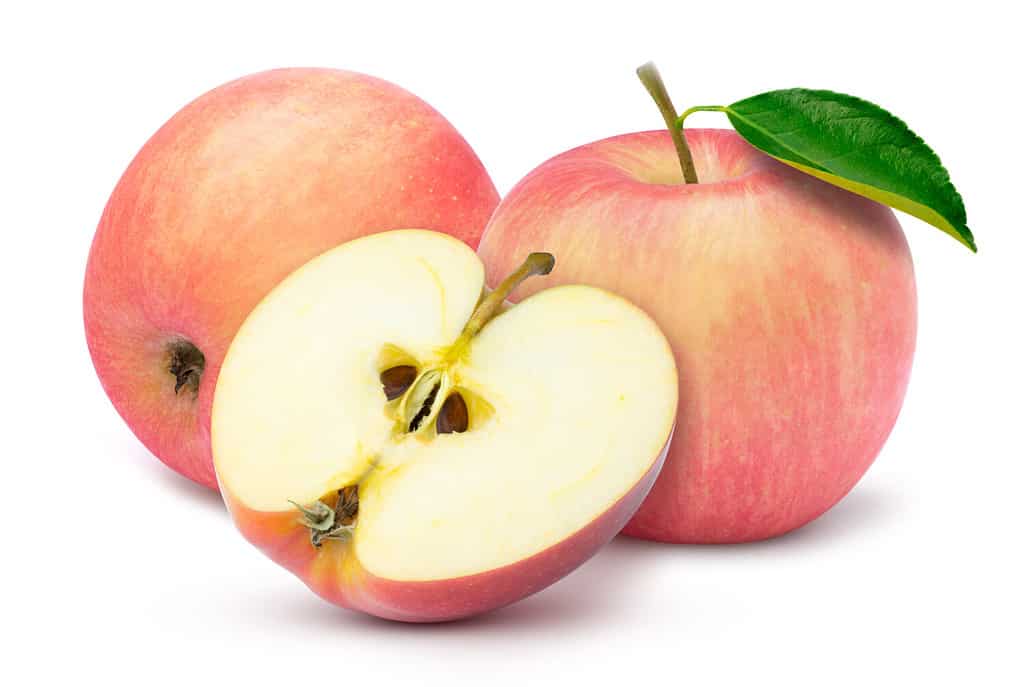
The Fuji apple was combined with the Crispin apple to develop the biggest apple in the world.
©NIKCOA/Shutterstock.com
- The world’s largest recorded apple weighed as much as a brick.
- The biggest apple in the world was a mix of Crispin and Fuji apple varieties.
- Apples can be small, medium, or large.
- A few large apple varieties include Mollie’s Delicious, Shizuka, and Goldrush.
- Apples are sized based on how many can fit in a standard box.
- Box sizes range from 48 to 216 apples.
- When choosing an apple tree to grow, consider bloom time.
- Some apple trees can live more than 100 years.
- Different apple cultivars have various uses.
- Some apples are perfect for baking, eating fresh, or making cider.
- A lot of the apples we eat today started out as wild crabapples.
How Big Was the World’s Biggest Apple?
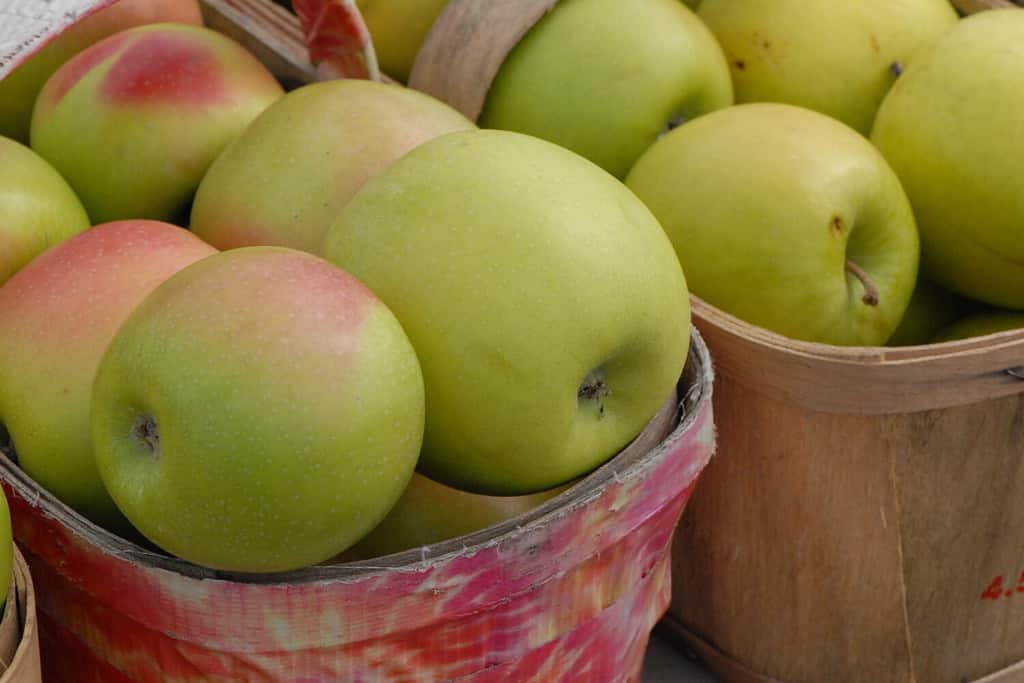
©Sax Lynn Francisco/Shutterstock.com
The world’s biggest apple on record weighed 4 pounds 1 ounce. Chisato Iwasaki picked the record-breaking fruit at his apple farm in Hirosaki City, Japan, on October 24, 2005. The monstrous apple was a blend of two large apple varieties, Crispin (Mutsu) and Fuji. Crispin apples are large, yellow-green, juicy, and flavorful. Fuji apples come in different sizes, ranging from big to very big, with an average diameter of about 3 inches. They have sweet and crunchy flesh. Both of these apple types are usually ready to pick in late October.
How Big Was the World’s Largest Apple Pie?
The world’s largest apple pie was an impressive 44 feet long, 24 feet wide, and 11.5 inches deep, weighing nearly 35,000 pounds. Wenatchee became the town known for baking the world’s largest apple pie in 1997. You need about 2 pounds of apples to make a delicious 9-inch pie. So, baking a pie that’s 44 feet long and 24 feet wide would require a whole lot of apples.
Record for the World’s Largest Apple Peel
The world’s largest, unbroken apple peel was 172 feet and 4 inches long. In 1976, 16-year-old Kathy Wafler Madison from the U.S. achieved this remarkable feat at Long Ridge Mall in Rochester, New York. She spent an impressive 11 hours and 30 minutes peeling an apple, resulting in a peel over half the length of a football field. It’s worth noting that Kathy later became a sales manager for an apple tree nursery.
Apple Sizes: What’s Considered Large?
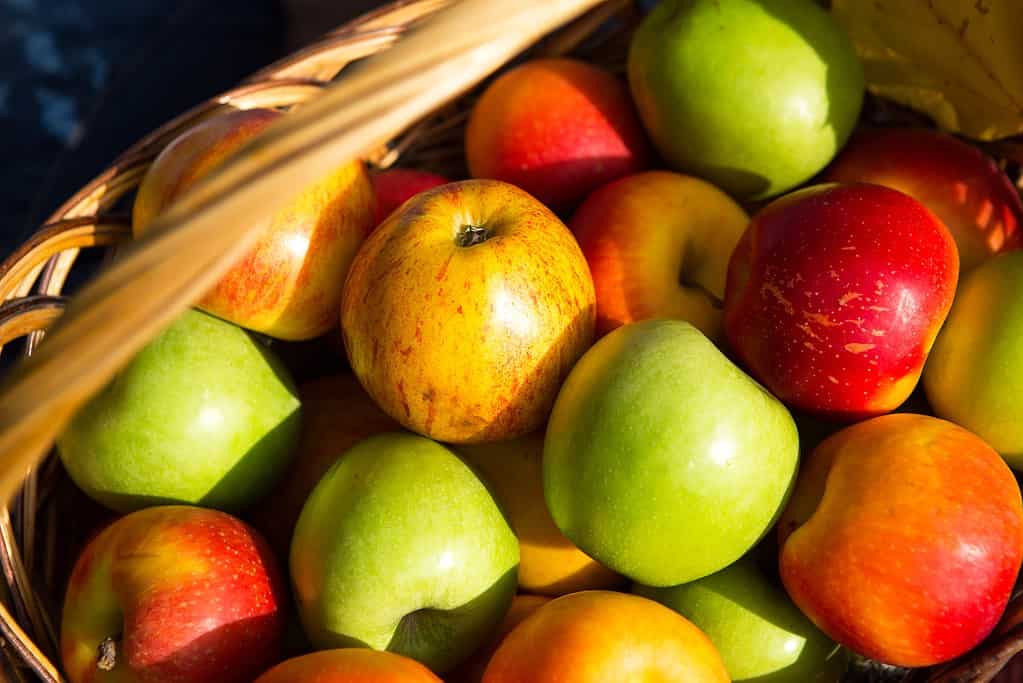
An average large apple measures around 3¾ inches in diameter.
©Simol1407/Shutterstock.com
When it comes to the diameter of apples, there are three typical sizes. A small apple is about 2¼ inches in diameter, a medium apple is about 2¾ inches, and a large apple measures around 3¾ inches. These measurements put into perspective how mind-blowingly massive the world’s largest apple was — a whopping 4 pounds 1 ounce. No doubt, this monster apple had an impressive diameter.
Apples are sized according to how many can fit in a standard box. The sizes can range from 48 to 216, with smaller numbers indicating larger apples and vice versa. When the apples are tiny, you can fit over 200 in a box. But when you’re dealing with monster-sized apples, you’ll be lucky to fit 48.
Choosing an Apple Variety to Grow
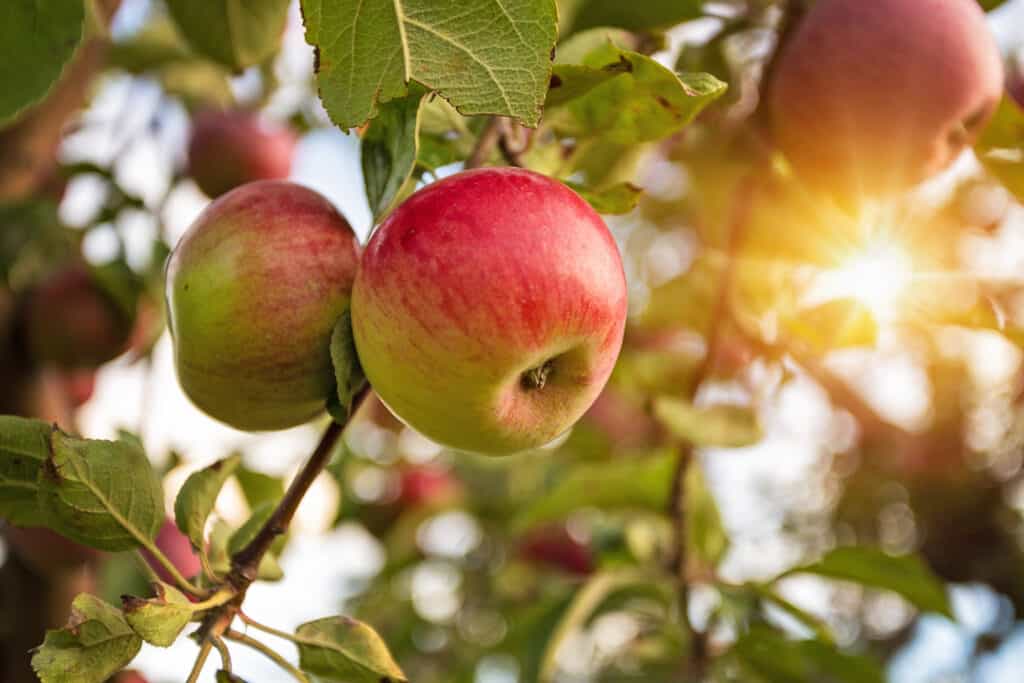
Plant more than one apple tree for fruit production through cross-pollination.
©Romiana Lee/Shutterstock.com
Do you dream of picking an enormous apple that you grow yourself? Eating and sharing food you grow is rewarding on so many levels.
If you want to grow an apple tree in your yard, remember these key points:
- Plant more than one tree for fruit production through cross-pollination.
- Make sure the apple tree you select can thrive in your climate zone.
- Plant trees close together if they bloom at similar times for effective pollination.
Cross-Pollination
Check if the apple tree needs another tree nearby for pollination. Some types can pollinate themselves, but having a second tree nearby can lead to a better harvest. Apple trees bloom at different times, so it’s crucial to choose ones that bloom at the same time for good cross-pollination. Also, make sure the tree will fit in your yard when it’s fully grown.
One more thing to note: Some apple trees are “triploid,” which means they need two other pollinators to produce fruit. If you have enough space, you can grow multiple trees to help with cross-pollination. Some apple trees can grow really tall, reaching over 40 feet, and live for more than 100 years. The oldest apple tree in the Pacific Northwest is right around 200 years old.
Disease Resistance
Disease resistance is essential too. You don’t want your young apple tree to struggle with pests and diseases as it grows into a mature fruit-bearing tree. It’s also essential to choose an apple variety that suits your location and the climate.
Fruit Characteristics
Next, think about the flavor and characteristics of the fruit. Different apple cultivars have various uses. Consider what you want to do with your apples when choosing a variety. Will you be baking, eating fresh, or turning them into cider?
Some apples work best fresh, like Red Delicious (they go perfectly in a salad). Rome Beauty apples work well for baking and fresh eating. Additionally, certain apple cultivars are particularly well-suited for crafting delicious cider. Keep in mind that producing a gallon of apple cider typically requires around 36 apples.
Large Apple Varieties
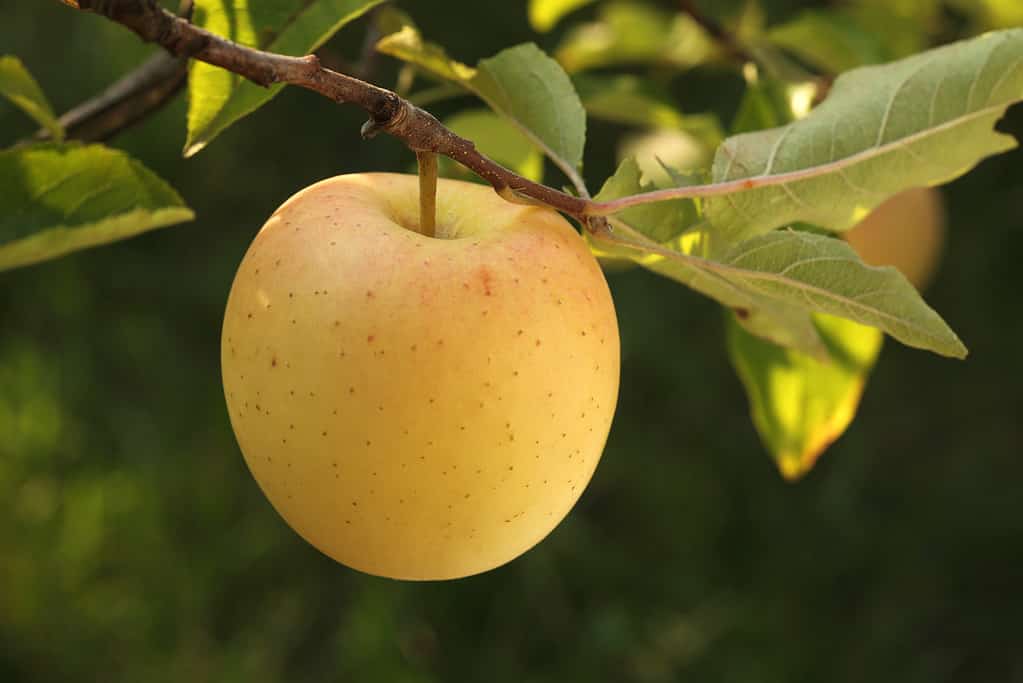
Golden delicious apples range in size from medium to quite large.
©Shulevskyy Volodymyr/Shutterstock.com
Apple sizes range from tiny cherry tomato size to as large as a softball, and sometimes bigger. To grow a monster-sized apple, pick the right variety. Some apple varieties are known for producing really large apples, like Mollie’s Delicious. These apples range in size from large to very large. They have a conical shape, are pinkish-red in color, and usually ripen early, from late summer to fall.
Ever heard of Shizuka apples? They’re a hybrid between golden delicious and Indo. These apples are large, with green to yellow skin, and they ripen in mid-October.
Lastly, consider Goldrush apples. They’re large, yellow, semi-tart, and juicy. You can find them ripe in late October. Keep in mind that the sizes and ripening times might vary depending on where the apples are grown and the climate.
Small Apple Varieties
Rockit Apples are the mini wonders of the apple world. It’s a small-sized fruit with a burst of juicy, fresh flavor. Their story began when the minds behind Rockit Apples realized how much kids adored apples. But they also knew that munching on a full-sized apple could sometimes be a challenge for those tiny hands and teeth. So, they put on their thinking caps and embarked on a mission to create the ultimate snack-size apple. The result? Rockit Apples, which come in a bit smaller than a ping pong ball. An added bonus for Rockit Apples is how fast they can produce these tiny fruits. The apples are so small, the trees often end up bearing loads of fruits on a single plant.
There’s another pint-sized apple making waves at UK supermarkets. Marks & Spencer, the innovators that they are, introduced “Tiddly Pomme,” the smallest apple to hit their stores. These adorable mini versions of the Royal Gala apple are 1.6 inches in diameter.
Advantages of Older Apple Varieties over New Ones
Scientists studied different types of apples, both old varieties and new ones, to see which ones have more polyphenols, a special substance that fights harmful free radicals. It turns out the older apples had more polyphenols and were better at protecting our bodies. One such apple is Boskoop (also known as Boskop or Boskoop). Another old-timer, chock full of polyphenols, is Braeburn.
Some older apple varieties are at risk of disappearing, which would mean losing the opportunity to taste their unique flavors forever. Thankfully, passionate pomologists are working hard to preserve the rich diversity of apple genetic material, thereby keeping a part of our cultural history alive. The science of apple growing is called pomology, which is a branch of botany that studies fruits and their cultivation.
Are All Apples Picked by Hand?
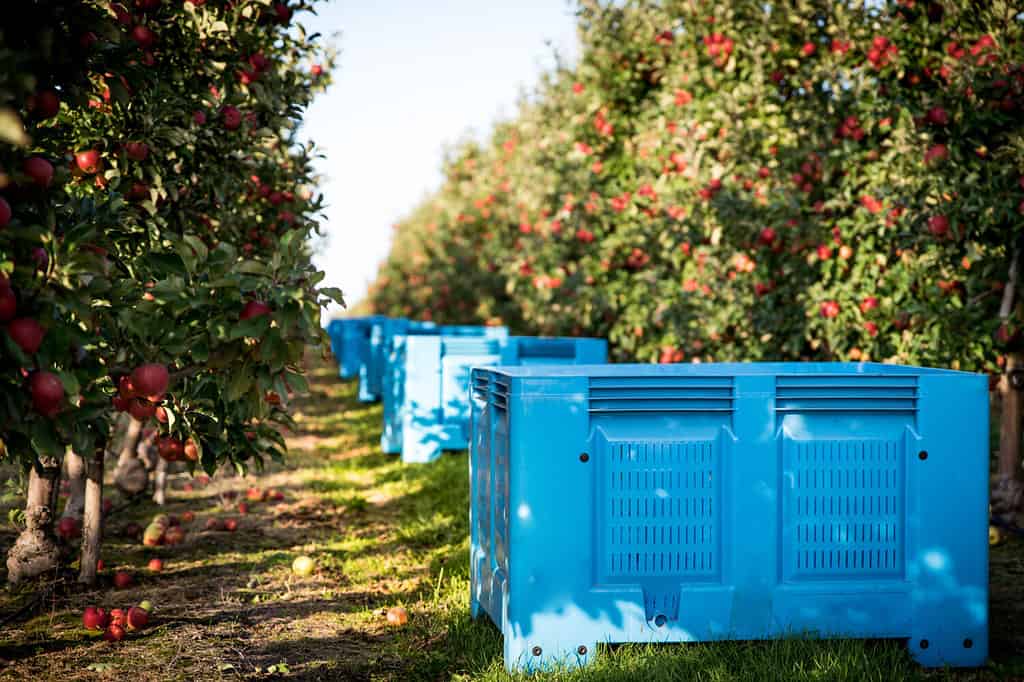
Apples are gently rolled into bins to prevent bruising.
©Chatham172/Shutterstock.com
Yes, every apple you buy from the store is hand-picked. Thousands of workers are involved in this process to make sure the fruits don’t get bruised or damaged. They use ladders to reach the apples in orchards that can be as big as 100 acres or even 4,000 acres!
Once the pickers reach the apple trees, they climb up the ladders and reach into the branches to grab the apples. Their hands move quickly, relying on muscle memory, as they collect the apples and put them into bags attached to their waists. These bags make it easier to carry the apples without dropping or bruising them.
When it’s time to transport the picked apples, they’re careful to avoid bruising or damaging them. The workers gently roll the apples into bins. This ensures that the apples you buy at the store are in perfect condition, and not ugly and bruised.
After the apples are picked, they are taken to a packaging facility for inspection. There, the apples undergo a thorough check to ensure they are of good quality. The apples are sorted into different groups based on their size, ripeness, and appearance. This way, you get the best apples available. Some orchards produce way more than others. Chazy Orchards, the home of the biggest Mcintosh Apples ever recorded, produces nearly 300,000 bushels of apples every year.
Tips for Apple Picking — Get Ready to Pick Your Own Apples
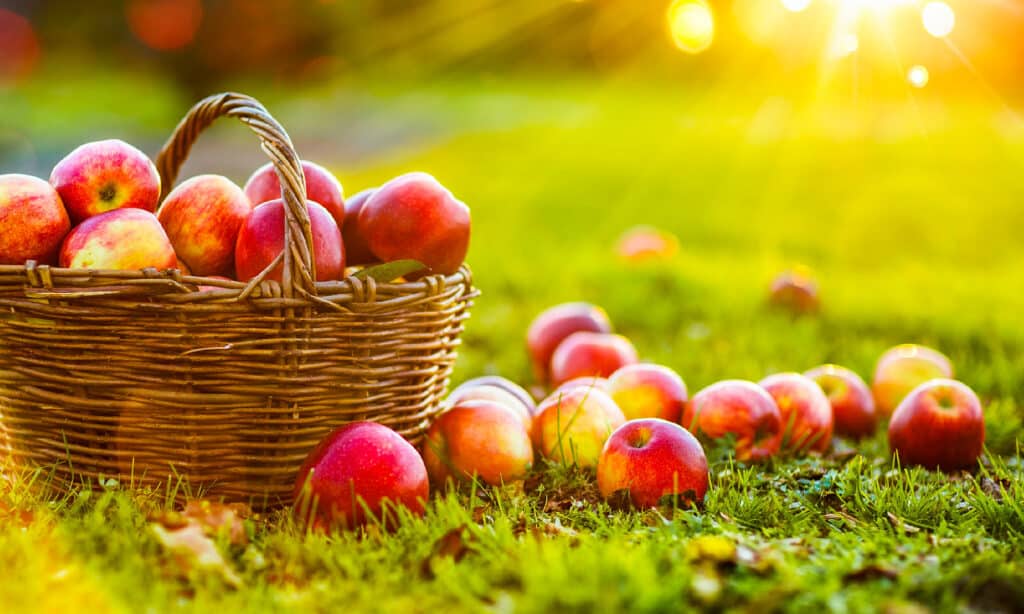
Using your palms when apple picking helps keep your apples firm and unbruised.
©iStock.com/Baks
Apple picking is a fun activity for everyone. The best time for apple picking is usually from September to early October, with various apple varieties available, ranging from sweet to tart with different textures. To start, find a pick-your-own orchard nearby using.
Use your palm to pick apples to avoid bruising them. If an apple falls on the ground while picking, you can still use it, but avoid picking ones already on the ground. Handle them with care to prevent bruising and spoilage. Avoid picking any apples with bruises or cuts.
When picking apples, lift them gently and give a slight twist to release them from the tree. Don’t pull down or shake the branch. Keeping the stem on the apple helps it stay fresh. If apples bunch together at the top they’ll come off together when picked.
Timing is crucial. Apples don’t ripen more after picking them. So keep your eyes own for ripe ones. Ripe apples are firm and crisp, and they ripen from the outside of the tree to the trunk.
How should you store your apples? For longer shelf life, store the apples in a cool basement or the refrigerator’s fruit/vegetable drawer after picking. Keep apples away from potatoes since potatoes release gas that can make apples spoil faster. Only wash the apples just before using them to prevent spoilage. When you’re all stocked up on apples, find out what other fruits are in season. Maybe you’ll be able to make a tasty fruit salad or delicious pie.
Bushel vs. Peck: How Many Apples Do You Need?
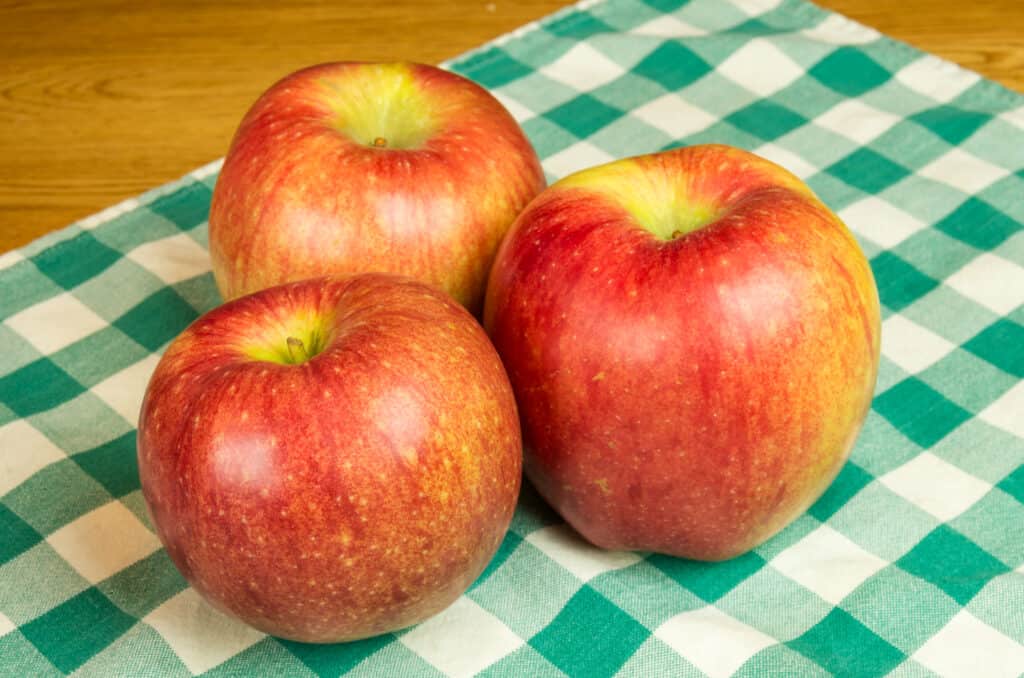
Before picking apples, think about what you’ll use them for so you choose the right amount.
©Zigzag Mountain Art/Shutterstock.com
Do you want a bushel or a peck? When you go apple picking, you have options for the amount of apples you can take home. There are three sizes: peck, half-bushel, and bushel.
- Peck: About 28 medium-sized apples.
- Bushel: About 100 medium-sized apples.
A peck is the smallest, holding about 10 pounds of apples. It’s like having about 28 medium-sized apples, which is 1/4 of a bushel. The largest option is the bushel, which holds about 45 pounds of apples, or 100 medium-sized apples. Some orchards will have different ways of doing things, like letting you fill your own bags.
Before you pick a size, choose what you’ll use the apples for, so you can choose the right types and amounts you will be baking, eating, or making applesauce. You’ll need 7-8 apples for a regular pie and 10-12 for a deep dish pie. To make applesauce, 6 large apples are enough for 4 servings. And if you’re just eating them fresh, consider how many people you’ll be sharing your apple bounty with. And remember, certain apple varieties last longer than others.
Secrets for the Perfect Apple Pie
What’s the secret to making an amazing, mouthwatering apple pie? It all starts with keeping things chilly. Always keep your ingredients cold, especially the homemade dough. After preparing the dough, wrap it in plastic wrap and let it chill in the fridge for about 30 minutes. This step is crucial for achieving a perfectly flaky crust that will melt in your mouth.
You should also consider using cornstarch in your apple pie filling. It not only adds a glossy thickness but also imparts a beautiful sheen to the filling. Additionally, the combination of cornstarch and flour gives the filling a creamy texture that will make every bite delightful.
When choosing apples for your pie, go for slightly tart ones that are also sweet and firm. These apples strike the perfect balance between tanginess and sweetness, making your pie incredibly enjoyable. Don’t be afraid to mix up different apple varieties. Combining apples with different flavors and textures will add complexity to your pie’s taste. For example, Granny Smith apples, known for their tartness and firmness, are a popular choice among professional bakers. They pair well with added sugar in pie recipes, and their crunch holds up well during baking.
As for the crust, opt for an all-butter crust. Butter adds a rich and delicious flavor to your pie, taking it to the next level of yum. To get a crisp bottom crust, try this nifty trick: brush the bottom and sides of the crust with an egg wash after pre-baking the pie. Then, reheat it briefly at 400°F for four minutes to set the glaze. This creates a seal between the crust and the filling, helping your crust stay crispy and golden even after adding the filling.
Apples Are a Nutritional Powerhouse
Fresh apples really can help keep the doctor away. They may even be a key for aiding in weight loss. The magic comes from whole apples, not applesauce or apple juice. Whole apples are best because they take longer to digest in your stomach. Plus, these fruits have loads of fiber and water, which can help you feel full and satisfied.
Research shows that including apples in your diet may help reduce your risk of heart disease. They have a positive impact on Body Mass Index (BMI), a factor related to weight and heart health. This is partly thanks to the apple polyphenols.
Where Do Apples Come From?

Just like a beautiful rose, apples belong to the Rosaceae plant family.
©lovelypeace/Shutterstock.com
During the Cretaceous period, 80 million years ago, the Earth’s climate was perfect for plants to thrive. Among them, there was an early form of rose that grew close to the ground. This special rose was one of the first flowering plants to emerge. As time passed, over thousands and thousands of years, many of the fruits we enjoy today evolved from this very rose. Apples, cherries, pears, apricots, plums, quinces, peaches, strawberries, raspberries, and blackberries, all belong to the Rose (Rosaceae) plant family.
The origin of the modern table apple is still a topic of debate. It’s widely accepted that apples did not originate in North America. All four apple species found in North America are crabapples. They are the sweet crabapple, the Oregon/Pacific crabapple, the Southern crabapple, and the prairie crabapple.
Some theories suggest they come from Kazakhstan, a country in central Asia, east of the Caspian Sea. Kazakhstan’s former capital was named Alma Ata, which means “father of apples” or “full of apples.” Other theories propose that they originated in the Caucasus Mountains in southwest Asia.
Apple Timeline
Around 1,500 BC, apple seeds had already spread throughout Europe. Apple trees eventually made their way to the Western Hemisphere. Apples were popular for making cider, a popular fermented apple drink among early American settlers. Apples were also helpful in a lot of folk remedies to make herbal teas, and sometimes even alcohol. Over time, many different apple varieties emerged in the United States. Today, apples remain an essential fruit tree crop.
Final Thoughts: Biggest Apple in the World
The biggest apple in the world weighed a record-breaking 4 pounds 1 ounce, which is like having a small dumbbell in your hand. It takes about three large apples to make 1 pound. So, for one apple to weigh 4 pounds is outrageous. The enormous apple was a hybrid of two large varieties, Crispin (Mutsu) and Fuji. Can you picture sinking your teeth into such a gigantic piece of fruit?
Besides its impressive size, another noteworthy fact about the record-breaking apple is its origin — it was picked right from Chisato Iwasaki’s apple farm. It’s enough to make you daydream about growing your own apples someday. Who knows? Maybe you’ll be the next one setting a record!
But before you embark on your apple-growing journey, keep in mind that choosing the right apple variety is essential for successful cultivation. Factors like bloom time, pollination needs, size, and disease resistance all play critical roles in achieving a bountiful harvest. And if you want to maximize your yield, consider planting multiple trees for cross-pollination. With the right knowledge and effort, you could have a flourishing apple orchard of your own.
Of course, you don’t have to grow your own trees to enjoy apple picking. Get out there and pick some for yourself at a local orchard. Get a small peck, or buy an entire bushel. The choice is yours.
The photo featured at the top of this post is © MERCURY studio/Shutterstock.com
Thank you for reading! Have some feedback for us? Contact the AZ Animals editorial team.







